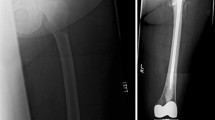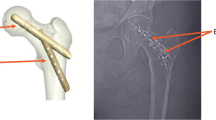Abstract
Background
The proximal femur is the most common site of surgery for bone metastases, and stabilization may be achieved through intramedullary fixation (IMN) or endoprosthetic reconstruction (EPR). Intramedullary devices are less expensive, less invasive, and may yield improved function over endoprostheses. However, it is unclear which, if either, has any advantages.
Questions/purposes
We determined whether function, complications, and survivorship differed between the two approaches.
Methods
We retrospectively reviewed 158 patients with 159 proximal femur metastatic lesions treated with surgical stabilization. Forty-six were stabilized with IMN and 113 were treated with EPR. The minimum followup was 0.25 months (mean, 16 months; median, 17 months; range, 0.25–86 months).
Results
The mean Musculoskeletal Tumor Society score was 24 of 30 (80%) after IMN and 21 of 30 (70%) after EPR. There were 12 complications (26%) in the IMN group, including 10 nonunions, six of which went on to mechanical failure. There were complications in 20 of 113 (18%) of the EPR group, which consisted of 10 dislocations (9%) and 10 infections (9%). There were no mechanical failures with EPR. Both implants remained functional for the limited lifespan of these patients in each group at all time intervals. EPRs were associated with increased implant longevity compared with IMNs (100% versus 85% 5-year survival, respectively) and a decreased rate of mechanical failure (0% versus 11%, respectively) when compared with the intramedullary devices.
Conclusions
Patients with metastatic disease to the proximal femur may live for long periods of time, and these patients may undergo stabilization with either IMN or EPR with comparable functional scores and the implant survivorship exceeding patient survivorship at all time intervals. Endoprostheses demonstrate a lower mechanical failure rate and a higher rate of implant survivorship without mechanical failure than IMN devices.
Level of Evidence
Level III, therapeutic study. See Guidelines for Authors for a complete description of levels of evidence.



Similar content being viewed by others
References
Baloch KG, Grimer RJ, Carter SR, Tillman RM. Radical surgery for the solitary bone metastasis from renal cell carcinoma. J Bone Joint Surg Br. 2000;82:62–67.
Barwood SA, Wilson JL, Molnar RR, Choong PFM. The incidence of acute cardiopulmonary and vascular dysfunction following intramedullary nail fixation of femoral metastases. Acta Orthop Scand. 2000;71:147–152.
Bong MR, Kummer FJ, Koval KJ, Egol KA. Intramedullary nailing of the lower extremity. J Am Acad Orthop Surg. 2007;15:97–106.
Cannon CP, Mirza AN, Lin PP, Lewis VO, Yasko AW. Proximal femoral endoprosthesis for the treatment of metastatic. Orthopedics. 2008;31:361.
Chandrasekar CR, Grimer RJ, Carter SR, Tillman RM, Abudu A, Buckley L. Modular endoprosthetic replacement for tumours of the proximal femur. J Bone Joint Surg Br. 2009;91:108–112.
Dijstra S, Wiggers T, Geel BTV, Boxma H. Impending and actual pathological fractures in patients with bone metastases of long bones: a retrospective study of 233 surgically treated patients. Eur J Surg. 1994;160:535–542.
Enneking WF, Dunham W. A system for the functional evaluation of reconstructive procedures after surgical treatment of tumors of the musculoskeletal system. Clin Orthop Relat Res. 1993;286:241–246.
Finstein JL, King JJ, Fox FJ, Ogilvie CM, Lackman RD. Bipolar proximal femoral replacement prostheses for musculoskeletal neoplasms. Clin Orthop Relat Res. 2007;459:66–75.
Gruen TA, McNeice GM, Amstutz HC. ‘Modes of failure’ of cemented stem-type femoral components: a radiographic analysis of loosening. Clin Orthop Relat Res. 1979;141:17–27.
Haentjens P, de Neve W, Casteleyn PP, Opdecam P. Massive resection and prosthetic replacement for the treatment of metastases of the trochanteric and subtrochanteric femoral region bipolar arthroplasty versus total hip arthroplasty. Acta Orthop Belg. 1993;59(Suppl 1):367–371.
Hage WD, Aboulafia AJ, Aboulafia DM. Incidence, location, and diagnostic evaluation of metastatic bone disease. Orthop Clin North Am. 2000;31:515–528.
Harrington KD. Orthopaedic surgical management of skeletal complications of malignancy. Cancer. 1997;80:1614–1627.
Hunt KJ, Gollogy S, Randall RL. Surgical fixation of pathologic fractures. Bull Hosp Joint Dis. 2006;63:77–82.
Kerr PS, Jackson M, Atkins RM. Cardiac arrest during intramedullary nailing for femoral metastases. J Bone Joint Surg Br. 1993;75:972–973.
Lin PP, Mirza AN, Lewis VO, Cannon CP, Tu SM, Tannir NM, Yasko AW. Patient survival after osseous metastases from renal cell carcinoma. J Bone Joint Surg Am. 2007;89:1794–1801.
Marcove RC, Yang DJ. Survival times after treatment of pathologic fractures. Clin Orthop Relat Res. 1982;169:109–114.
Menendez LR, Ahlmann ER, Kermani C, Gotha H. Endoprosthetic replacement for neoplasms of the proximal femur. Clin Orthop Relat Res. 2006;450:46–51.
Mirels H. Metastatic disease in long bones. Clin Orthop Relat Res. 1989;249:256–264.
Nilsson J, Gustafson P. Surgery for metastatic lesions of the femur: good outcome after 245 operations in 216 patients. Injury. 2008;39:404–410.
O’Neill DA, Harris WH. Failed total hip replacement: assessment by plain radiographs, arthrograms, and aspiration of the hip joint. J Bone Joint Surg Am. 1984;66:540–546.
Park DH, Jaiswal PK, Al-Hakim W, Aston WJS, Pollock RC, Skinner JA, Cannon SR, Briggs TWR. The use of massive endoprostheses for the treatment of bone metastases. Sarcoma. 2007;62:1–5.
Potter BK, Chow VE, Adams SC, Letson GD, Temple HT. Endoprosthetic proximal femur replacement: metastatic versus primary tumors. Surg Oncol. 2009;18:343–349.
Rompe JD, Eysel P, Hopf C, Heine J. Metastatic instability at the proximal end of the femur. Comparison of endoprosthetic replacement and plate osteosynthesis. Arch Orthop Trauma Surg. 1994;113:260–264.
Samsani SR, Panikkar V, Venu KM, Georgiannos D, Calthorpe D. Breast cancer bone metastasis in femur: surgical considerations and reconstruction with long gamma nail. Eur J Surg Oncol. 2004;30:993–997.
Selek H, Basarir K, Yildiz Y, Saglik Y. Cemented endoprosthetic replacement for metastatic bone disease in the proximal femur. J Arthroplasty. 2008;23:112–117.
Van Doorn R, Stapert JWJL. Treatment of impending and actual pathological femoral fractures with the long gamma nail in the Netherlands. Eur J Surg. 2000;166:247–254.
Ward WG, Holsenbeck S, Dorey FJ, Spang J, Howe D. Metastatic disease of the femur: surgical treatment. Clin Orthop Relat Res. 2003;415(Suppl):S230–244.
Wedin R, Bauer HC. Surgical treatment of skeletal metastatic lesions of the proximal femur: endoprosthesis or reconstruction nail? J Bone Joint Surg Br. 2005;87:1653–1657.
Wedin R, Bauer HCF, Wersall P. Failures after operation for skeletal metastatic lesions of long bones. Clin Orthop Relat Res. 1999;358:128–139.
Yazawa Y, Frassica FJ, Chao EY, Pritchard DJ, Sim FH, Shives TC. Metastatic bone disease. A study of the surgical treatment of 166 pathologic humeral and femoral fractures. Clin Orthop Relat Res. 1990;251:213–219.
Acknowledgment
We thank Stacy R. Collen, PhD, for her statistical analysis of the data in this study.
Author information
Authors and Affiliations
Corresponding author
Additional information
One author certifies that he (LRM) has or may receive payments or benefits, in any 1 year, an amount in excess of $10,000 from a commercial entity (Stryker Orthopaedics, Rutherford, NJ) related to this work.
Each author certifies that his or her institution has approved the human protocol for this investigation, that all investigations were conducted in conformity with ethical principles of research, and informed consent for participation in the study was obtained.
About this article
Cite this article
Harvey, N., Ahlmann, E.R., Allison, D.C. et al. Endoprostheses Last Longer Than Intramedullary Devices in Proximal Femur Metastases. Clin Orthop Relat Res 470, 684–691 (2012). https://doi.org/10.1007/s11999-011-2038-0
Published:
Issue Date:
DOI: https://doi.org/10.1007/s11999-011-2038-0




